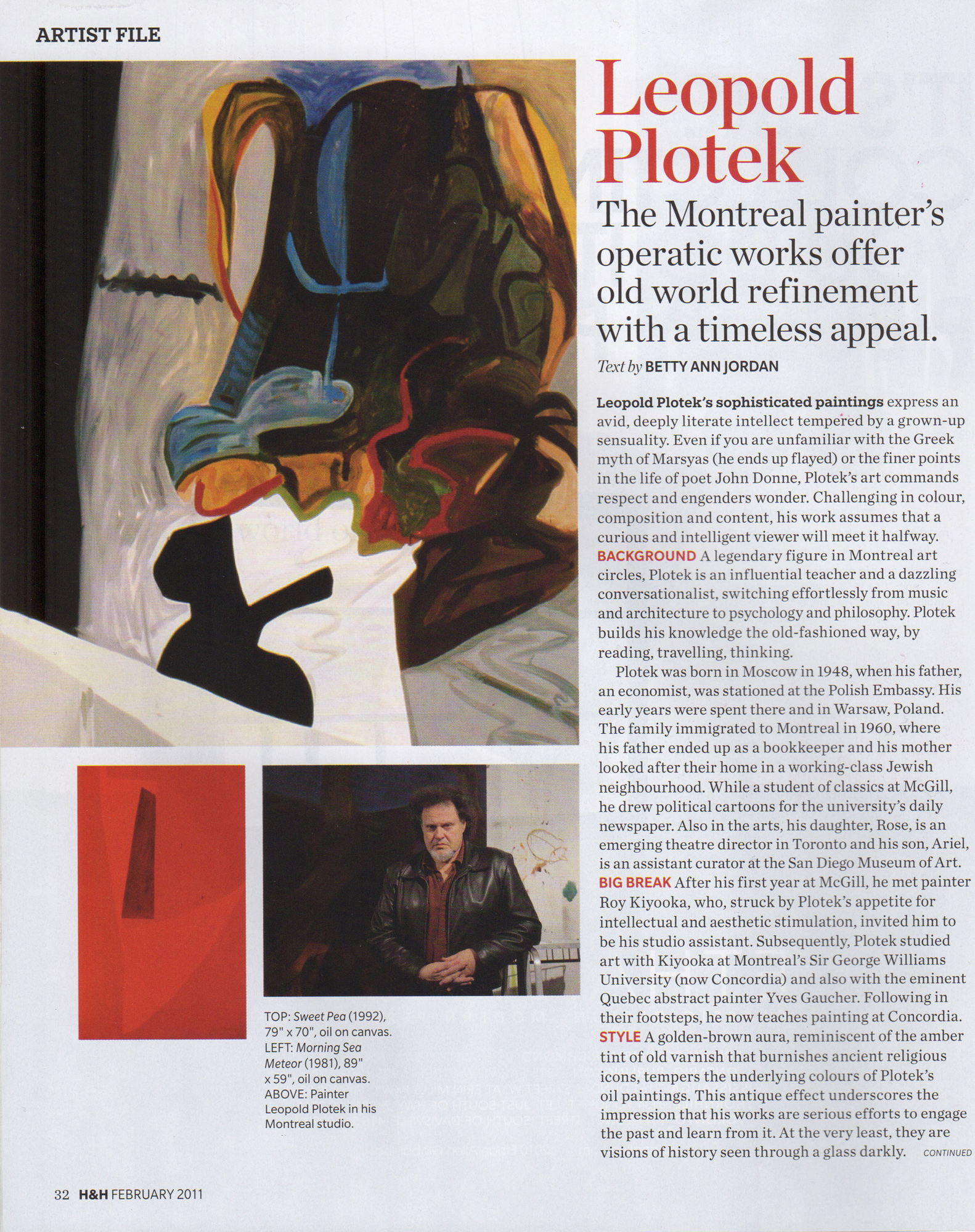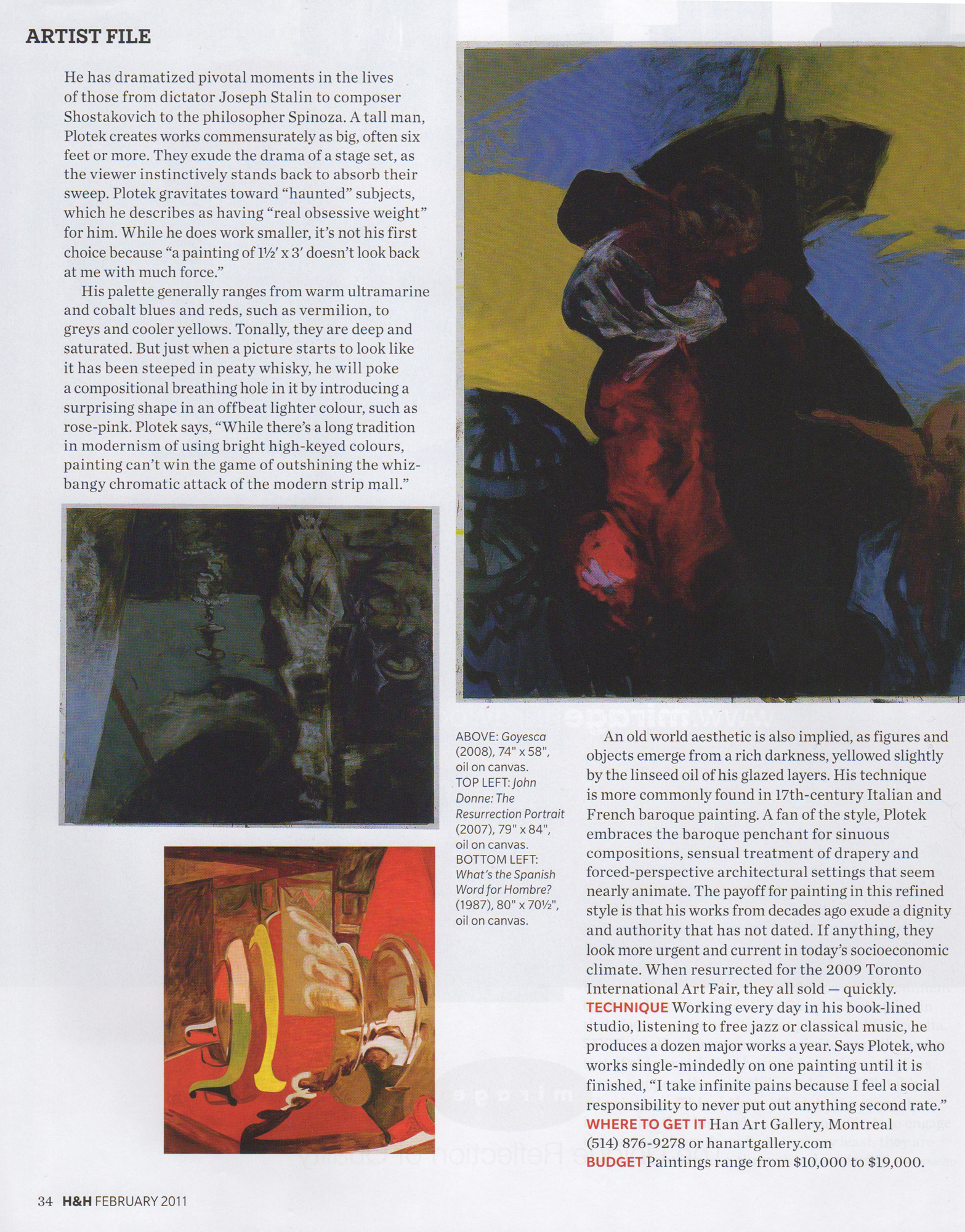ARTIST FILE: LEOPOLD PLOTEK
by Betty Ann Jordan
The Montreal painter’s operatic works offer old world refinement with a timeless appeal.
Leopold Plotek’s sophisticated paintings express an avid, deeply literate intellect tempered by a grown—up sensuality. Even if you are unfamiliar with the Greek myth of Marsyas (he ends up flayed) or the finer points in the life of poet John Donne, Plotek’s art commands respect and engenders wonder. Challenging in colour, composition and content, his work assumes that a curious and intelligent viewer will meet it halfway.
Background:
A legendary figure in Montreal art circles, Plotek is an influential teacher and a dazzling conversationalist, switching effortlessly from music and architecture to psychology and philosophy. Plotek builds his knowledge the old—fashioned way, by reading, travelling, thinking.
Plotek was born in Moscow in 1948, when his father, an economist, was stationed at the Polish Embassy. His early years were spent there and in Warsaw, Poland. The family immigrated to Montreal in 1960, where his father ended up as a bookkeeper and his mother looked after their home in a working—class Jewish neighbourhood. While a student of classics at McGill, he drew political cartoons for the university’s daily newspaper. Also in the arts, his daughter, Rose, is an emerging theatre director in Toronto and his son, Ariel, is an assistant curator at the San Diego Museum of Art.
Big Break:
After his first year at McGill, he met painter Roy Kiyooka, who, struck by Plotek’s appetite for intellectual and aesthetic stimulation, invited him to be his studio assistant. Subsequently, Plotek studied art with Kiyooka at Montreal’s Sir George Williams University (now Concordia) and also with the eminent Quebec abstract painter Yves Gaucher. Following in their footsteps, he now teaches painting at Concordia.
Style:
A golden—brown aura, reminiscent of the amber tint of old varnish that burnishes ancient religious icons, tempers the underlying colours of Plotek’s oil paintings. This antique effect underscores the Leopold Plotek in his Montreal Studio‘ impression that his works are serious efforts to engage the past and learn from it. At the very least, they are visions of history seen through a glass darkly.
He has dramatized pivotal moments in the lives of those from dictator Joseph Stalin to composer Shostakovich to the philosopher Spinoza. A tall man, Plotek creates works commensurately as big, often six feet or more. They exude the drama of a stage set, as the viewer instinctively stands back to absorb their sweep. Plotek gravitates toward “haunted” subjects, which he describes as having “real obsessive weight” for him. While he does work smaller, it’s not his first choice because “a painting of 11/2’ x 3' doesn’t look back at me with much force.”
His palette generally ranges from warm ultramarine and cobalt blues and reds, such as Vermilion, to greys and cooler yellows. Tonally, they are deep and saturated. Butjust when a picture starts to look like it has been steeped in peaty whisky, he will poke a compositional breathing hole in it by introducing a surprising shape in an offbeat lighter colour, such as rose-pink. Plotek says, “While there’s a long tradition in modernism of using bright high-keyed colours, painting can’t win the game of outshining the whiz- bangy chromatic attack of the modern strip mall.”
An old world aesthetic is also implied, as figures and objects emerge from a rich darkness, yellowed slightly by the linseed oil of his glazed layers. His technique is more commonly found in 17th-century Italian and French baroque painting. A fan of the style, Plotek embraces the baroque penchant for sinuous compositions, sensual treatment of drapery and forced-perspective architectural settings that seem nearly animate. The payoff for painting in this refined style is that his works from decades ago exude a dignity and authority that has not dated. If anything, they look more urgent and current in today’s socioeconomic climate. When resurrected for the 2009 Toronto International Art Fair, they all sold — quickly.
Technique:
Working every day in his book-lined studio, listening to freejazz or classical music, he produces a dozen major works a year. Says Plotek, who works single—mindedly on one painting until it is finished, “I take infinite pains because I feel a social responsibility to never put out anything second rate.”


